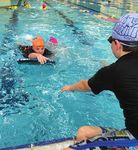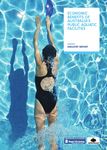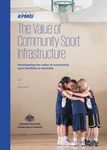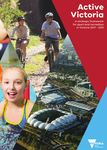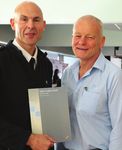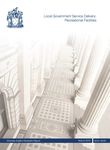Victorian Public Pools State of the Sector Report 2017/18 - Life Saving ...
←
→
Page content transcription
If your browser does not render page correctly, please read the page content below
About Life Saving Victoria About Aquatics & Recreation Victoria
(LSV) (ARV)
LSV was established in 2002 as an initiative ARV is a not-for-profit member-based
of the Royal Life Saving Society - Australia association providing support, professional
Victoria Branch (est. 1904) and Surf Life development, training, advocacy, research
Saving Victoria (est. 1947). and networking opportunities to those who
plan, build, own, operate or service aquatic
LSV’s mission is to prevent aquatic related death and recreation facilities across Victoria.
and injury. Its vision is that all communities will
learn water safety, swimming and resuscitation, ARV facilitates industry development and
and be provided with safe beaches, water research opportunities, conducts special
environments and aquatic venues. projects and studies to provide key information
on behalf of the industry. ARV works to provide
LSV works with communities, educational guidelines and benchmarks in consultation with
institutions, governments, businesses and industry, the tertiary sector and government.
the broader aquatic industry, across a
range of operations and services, including: ARV’s key role is to develop effective
seasonal beach lifesaving services; event partnerships by bringing industry organisations
lifesaving services; water safety education together to achieve a common goal.
and campaigns; aquatic leadership and
development; public aquatic and first aid training;
aquatic risk assessments; multicultural water
safety education; and research and evaluation.
Acknowledgements Definitions
LSV and ARV gratefully acknowledge the Community Issue-based Working Group
public pool representatives and government / A stakeholder group engaged to address the primary
industry agencies that contribute to water safety drowning prevention issues in Victoria (Victorian Water
across the Victorian public pool sector by: Safety Assembly, 2016).
• Contributing to industry committee and working Cryptosporidiosis Cryptosporidiosis is a type of
groups. gastroenteritis (gastro) caused by the parasite
Cryptosporidium (Better Health Channel, 2018).
• Attending industry conferences and events.
Guidelines for Safe Pool Operations Recommended
• Undertaking pool safety assessments.
minimum safety standard for swimming pools.
• Investing in staff training and professional
Platinum Pool Pools that are accredited as part of
development.
LSV’s Platinum Pool Program complete a combination
• Developing or supporting the provision of industry of assessment processes every 12 months and adhere
resources. to a strict code of practice.
• Participating in or facilitating industry research Pool Safety Assessment The auditing of a swimming
and evaluation. pool’s operational performance, against known
industry standards, behaviours and expectations,
specific to staff and patron safety.
Public pool A pool accessible to members of the
public in return for payment, including council-owned
pools; learn-to-swim pools; and early childhood care,
tertiary education, and higher education venue pools.Contents Aim, objectives and introduction 4
Sector facts and figures 5
Public pool use and customer insights 6
Distribution of Victorian public pools 8
Drowning statistics 10
Coronial recommendation 12
Major projects 13
• Safer Public Pools – Code of Practice
• Swimming in Schools
• Public Health and Wellbeing Regulations
2009 - Sunset Review
• Water Quality Guidelines for Public Aquatic Facilities
• National Swimming and Water Safety Framework
• Update to the Guidelines for Safe Pool Operations
• 2017-2018 Cryptosporidiosis notifications
Sector safety – Pool Safety Assessments 16
Research and industry strategies 18
• Vulnerable swimmers campaign
• Economic benefits of aquatic leisure facilities
• Sport and recreation industry skills forecast
• Changing parent supervision behaviour
• Community benefits of public pools
• Value of Community Sport Infrastructure
• Strategic Framework for Sport and Recreation in Victoria
• Non-Fatal Drowning Symposium
• Swimming and Water Safety Symposium
Industry awards 22
New facilities 24
• Oak Park Sports and Aquatic Centre
• Gurri Wanyarra Wellbeing Centre
• Eltham Leisure Centre
• Splash Aqua Park and Leisure Centre
Industry profiles 25
References 26
Stakeholder engagement opportunities 27
2017/18 Victorian Public Pools: State of the Sector Report 3Aim Introduction
The Victorian Public Pools Life Saving Victoria (LSV) and Aquatics and Recreation
- State of Sector Report is Victoria (ARV) are proud to present the inaugural
intended to be an annual Victorian Public Pools: State of the Sector Report.
document providing a In an industry first, Victoria’s two peak aquatic industry bodies
snapshot of the public are collaborating to support a better understanding of the
pool industry. The target Victorian public pools landscape. With the significant investment
audience is facility owners, that goes into building, operating and servicing the state’s
facility operators, aquatic public aquatic facilities, it is imperative that we are aware of the
industry agencies and true value that our industry provides to Victorian communities.
government departments. By working together, LSV and ARV are facilitating a greater
understanding of our sector and delivering better outcomes for
our members and stakeholders.
Objectives Building on the legacy of independent state of industry reports,
this annual publication will provide a broad snapshot of the
The objectives of this overall public pools industry. This inaugural report will set an
report are to provide: initial benchmark, which can then be used to better track and
compare key metrics such as industry size, breadth and both
• An overview of the size, social and economic value. It will act as one true source of
scope and value of the information, supporting increased collaboration and enabling
industry. improved analysis and evaluation and more informed decision
making. The report will also provide an opportunity to publish key
• Analysis of safety industry updates, research, major projects and to acknowledge
assessments and achievements across the industry.
broader industry safety
performance and The information and data collected to contribute to this report
trends. has been provided by LSV, ARV, industry partners and publicly
available sources. Understanding and interpreting this data will
• An overview of sector provide a better insight to the size, performance and broader
projects, research and landscape of our sector and allow for smarter, more confident
future directions. and increased levels of investment in public pools.
• Details of key industry
award and event
winners.
• Insights into customer
use of public pools. Dr Nigel Taylor ESM Grant Connors
CEO CEO
Life Saving Victoria Aquatics &
Recreation Victoria
4 2017/18 Victorian Public Pools: State of the Sector ReportSector facts and figures
300
Victorian council-owned pools
266
Additional Victorian public access pools
70,000,000+
Visits to Victorian aquatic recreation facilities
(Victorian Water Safety Assembly, 2016)
40,000
Employees trained in water safety each year
(Skills IQ, 2018)
$933m
Four-year planned infrastructure spend
(Victorian Auditor General’s Office [VAGO], 2016)
$8.5b
Value of sport and recreation to the Victorian
economy (Sport and Recreation Victoria, 2017)
2017/18 Victorian Public Pools: State of the Sector Report 5Public pool
use and
customer
insights 16% 74%
Expected increase Of aquatic
in swim participant members live
Insights provided by: demand between within a 10 minute
2021 and 2033 drive
9.4 49
Months average Average number
membership lifetime of days since
of a swim member last visit before
membership
cancellation
The most common pool user profiles:
Out on the edge Maturing assets
• Home-owning • Educated, maturing
established families family households in
on outer metropolitan outer metropolitan
fringes suburbs
• Age 45-54 • Age 45-54
• School aged children • Older families
• Early technology • Adult children
adopters
• High household
• Watch more TV than expenditure
“maturing assets”
• Early technology
• Household income adopters
$65-78k
• Household income
$104-156k
6 2017/18 Victorian Public Pools: State of the Sector Reportpool users
Hourly split of
and pool user split
Population change
Percentage pool use
by user type between days
8%
0-4 18% 10% 5 3.4%
9%
Sunday 9% 5-9 28% 16% 6 7.2%
13% 18% 7 6.6%
19% 10-14
Visitor pass
17% 3% 19% 9.1%
15-19 8
Monday 18% 16%
20-24 2% 9 11.4%
Member percentage
18% 6% 8.2%
25-29 3% 10
Percentage of swimmers
16% 4%
4% 11 6.5%
Tuesday
Swim school
16% 30-34
12%
4% 12 4.3%
17% 35-39
26%
16% 4% 13 4.5%
40-44
Wednesday 17% 23%
14 4.9%
45-49 4%
8%
17% 15 5.0%
3%
Population growth
50-54 11%
15% 7.6%
16
Aquatic member
Thursday 16% 55-59 3% 14%
17 7.4%
60-64 3%
13% 19%
18 6.4%
13% 65-69 3% 24%
Friday 15% 19 3.9%
70-74 2% 40%
20 2.8%
7% 1% 62%
75-79
14% 21 0.6%
80+ 1% 51%
Age group (years)
Saturday 9%
2017/18 Victorian Public Pools: State of the Sector Report 7
0.1%
Hour of the day
22Distribution There are more than 550 public aquatic
of Victorian facilities in Victoria, providing infrastructure
and services for aquatic leisure,
public pools learn-to-swim, fitness and rehabilitation.
Regional
public pools
8 2017/18 Victorian Public Pools: State of the Sector ReportMetropolitan
public pools
Legend
Pool Type
Council (300)
Learn to Swim (184)
School / University (82)
Population density
3 people or fewer per km2
3.1 to 8.5 people per km2
8.6 to 138 people per km2
139 to 1575 people per km2
1576 to 4870 people per km2
2017/18 Victorian Public Pools: State of the Sector Report 9Drowning
statistics 20
Drowning deaths
in the past 20 years
From 2012/13
to 2016/17
there were 85%
five drowning Of drowning victims
were male
deaths, or an
average of one
death per year in
Victorian public 29 Median age of
pools. Years drowning victims
19
Non-fatal drowning
incidents in the
past 5 years
(2013/14 – 16/17)
Key contributing factors to fatal
drowning deaths:
Lack of Pre-existing
supervision medical conditions
10 2017/18 Victorian Public Pools: State of the Sector ReportFatal drowning Over the previous five year period from 2012/13 to 2016/17 there
were five drowning deaths or an average of one death per year. These
incidents drowning deaths in public swimming pools represent 2% of the total
unintentional drowning deaths in Victoria on average from 2012/13 to
There were no 2016/17.
drowning deaths
Further analysis of the 20 drowning deaths in public swimming pools
at public pools in over a 20-year period in Victoria revealed that the majority (75%, 15)
Victoria in the last occurred at council-owned pools, while the other 25% (5) occurred at
non-council owned pools (typically privately-owned health and fitness
financial year.
centres, or hotels/resorts).
The majority (85%, 17) of the deceased were male and the median age
was 29 years. Just over a third of cases occurred in the two-year periods
from 1998/1999 (35%, 7) and 2014/2015 (35%, 7). Key factors that
contribute to drowning deaths at public swimming pools are a lack of
supervision and pre-existing medical conditions (Life Saving Victoria [LSV],
2018a; Mahony, Peden, Roberts, & Barnsley, 2018).
Non-fatal drowning
There were on average 17 non-fatal drowning incidents in public
incidents
swimming pools attended by paramedics in the five-year period from
2012/13 to 2016/17.
There were nine
non-fatal drowning Non-fatal drowning incidents in public swimming pools represented
28% of the total non-fatal drowning incidents attended by paramedics
incidents at public in Victoria on average from 2012/13 to 2016/17. The leading age group
pools in Victoria in for non-fatal drowning was children aged 0-4 years (41%), followed by
children aged 5-14 years (28%) and adults aged 25-44 years (13%).
2017/18.
Frequency of fatal and
non-fatal drowning at
public pools 2012/13
to 2017/18
11 *
22
19
22
12
0
2
2
1
0
0
9
*Note: Some non-fatal drowning
2012/13
2013/14
2014/15
2015/16
2016/17
2017/18
data in 2014/15 is missing
due to industrial action by
paramedics. Fatal Non-fatal
2017/18 Victorian Public Pools: State of the Sector Report 11Coronial The following is a summary of the corner’s findings in relation to a
fatal drowning death at a Victorian metropolitan public pool in 2014.
recommendation (Note, this is not an exact replication from the findings; the full findings
can be accessed from the Coroners Court of Victoria.)
On 7 July 2017, Coroner Gregory McNamara handed down his findings
and recommendations into the 2014 fatal drowning of Mr Tony Guan at a
The role of the coroner Victorian metropolitan public pool.
in Victoria is to Mr Guan was seen floating face-down in the warm water pool and was
investigate reportable pulled unconscious from the water. Despite the efforts of the facility
deaths, which include lifeguards, he was unable to be resuscitated.
drowning, to determine It is believed that Mr Guan may have lost his footing in the warm water
pool, and due to muscle weakness resulting from amyotrophic lateral
the identity of the sclerosis (ALS), was unable to right himself. Tragically, Mr Guan was
person who died, the not wearing a flotation device nor directly supervised by a carer (as
cause of the death and, recommended by his doctor).
in some situations, A number of key matters were discussed throughout the inquest,
including:
the circumstances
• Staff training
surrounding the death.
• Lifeguarding systems
As part of this process • Non-supervisory tasks
the coroner may • Equipment availability
recommend ways to • Supervision of patrons with a disability
help prevent similar
Similar to other recent incidents, there was some contrary evidence and
deaths in the future. a level of confusion surrounding the supervision at the time whereby: “…
uncertainty arose from the system which allowed on duty lifeguards to do
tasks which took them away from their life saving duties …” and “… there
wasn’t a clear system in place to ensure transfer of responsibilities …”.
The Coroner found the cause of death to be ‘accidental drowning’
and made the following recommendations:
1 That ... the YMCA review its training and procedures to ensure that the
duties of life savers are clear when conducting supervisory and non-
supervisory tasks.
2 That the YMCA review its Pool Operations Manual (if that manual
in some form is still being used) to clarify the role and duties of
lifeguards.
3 That the YMCA review its training and procedures and continue
to engage with Life Saving Victoria current guidelines and
recommendations to ensure both that staff are trained sufficiently in
the need to identify and adequately supervise pool patrons in need of
closer supervision, and that staff are in practice doing this.
4 That the YMCA review its procedures to ensure that safety equipment
for lifeguards, and in - particular bum bags, is ready and available to
life savers before a shift is commenced.
(Coroners Court of Victoria, 2016)
12 2017/18 Victorian Public Pools: State of the Sector ReportMajor Safer Public Pools – Code of Practice
The Safer Public Pools - Code of Practice was launched by
projects Emergency Management Commissioner Andrew Crisp at LSV’s
seventh annual Pool Safety Summit in October 2018.
The code is part of the joint government and industry response to
Coroner Jamieson’s recommendation following a fatal drowning death at
a Victorian public pool in 2014, that:
“With the aim of promoting public health and safety and preventing like
deaths in public swimming pools, I recommended that Chris Eccles,
Secretary of the Department of Premier and Cabinet, work with the
appropriate area of Victorian Government to establish a central oversight
and regulation body for public swimming pool operation in Victoria, to
ensure safety standards are applied and upheld consistently across the
industry (Coroners Court of Victoria, 2016).
The code has been developed by LSV, in consultation with
representatives of employers, employees, aquatic industry and relevant
government agencies.
The code supports public swimming pool owners and operators to
provide the highest levels of safety at their respective facilities. It is
designed to work seamlessly with the Royal Life Saving Society -
Australia Guidelines for Safe Pool Operations and contribute to the
objectives set out through the Victorian Water Safety Strategy. It also
provides consistency regarding the application and review of industry
standards, bench-marking and reporting (LSV, 2018b).
Visit lsv.com.au/pool-safety-services/safer-pools-project/
Swimming in In March 2018, the Victorian Government announced that schools
across the state would receive an additional $9.8 million (over
Schools
two years) to help contribute to the cost of swimming lessons.
This follows an initial $9.2 million (over three years) announced in
May 2017.
The funding will support up to 60,000 students at government and
Catholic schools to achieve their Victorian School Water Safety
Certificate, before leaving primary school.
The government’s Swimming in Schools program aims to increase
opportunities for students to learn how to swim, and ensure they develop
lifelong skills in swimming and water safety to reduce their risk of
drowning and injury.
Visit blog.lsv.com.au/2018/03/27/support-swimming-lessons/
2017/18 Victorian Public Pools: State of the Sector Report 13Public Health and The Victorian Department of Health and Human Services is currently
reviewing the Public Health and Wellbeing Regulations 2009, which
Wellbeing Regulations ‘sunset’ (expire) on 15 December 2019.
2009 – Sunset Review
Part 6 of the regulations outlines maintenance and testing requirements
for aquatic facilities including water quality parameters to prevent and
control waterborne pathogens that can cause human illness.
Targeted industry consultation took place in July/August 2018, with the
Public Aquatic Facilities Discussion and Options Paper made available
for review and feedback.
The sunset review process is continuing to progress with additional
industry consultation in the preparation of new regulations in 2019
(State of Victoria Department of Health and Human Services, 2018a).
Visit www2.health.vic.gov.au/public-health/water/aquatic-facilities/
aquatic-facilities-consultation-documents
Water Quality In December 2018, the Victorian Department of Health and Human
Guidelines for Public Services will publish the Water Quality Guidelines for Public Aquatic
Facilities on its website.
Aquatic Facilities
The document has been prepared in conjunction with Queensland
Health and will replace the Victorian Pool Operators’ Handbook.
This document is intended to assist organisations and public pool
operators to reduce water quality risks to public health (State of Victoria
Department of Health and Human Services, 2018b).
Visit www2.health.vic.gov.au/public-health/water/aquatic-facilities/aquatic-
facilities-consultation-documents
National Swimming Following the National Swimming and Water Safety Symposium
and Water Safety hosted by the Royal Life Saving Society - Australia in 2017, the
National Swimming and Water Safety Reference Group was formed
Framework to review and update the existing framework (originally developed in
1999).
The revisions are currently undergoing an industry consultation process,
and are expected to be finalised in 2019 (Royal Life Saving Society -
Australia, 2018).
Visit www2.health.vic.gov.au/public-health/water/aquatic-facilities/aquatic-
facilities-consultation-documents
14 2017/18 Victorian Public Pools: State of the Sector ReportUpdates to the A number of updates to the Royal Life Saving Society - Australia’s
Guidelines for Safe Pool Operations have been released in 2018.
Guidelines for Safe
Pool Operations The revisions have been developed in conjunction with member
organisations from the National Aquatic Industry Safety Committee and
have also included extensive stakeholder engagement.
The document brings together the requirements for a safe aquatic
industry, as well as requirements from numerous regulatory and
guidance documents into a single, easy-to-read and interpret document.
The release of the Aquatic Supervision and Programs section of the
document is expected later this year.
The implementation of the guidelines have been incorporated into the
Victorian ‘Pool Safety Assessment’ process, ensuring a consistent and
holistic approach within Victoria.The new guidelines are considered
industry best practise and as such, aquatic facilities are advised to plan
ahead to ensure their continued compliance (Royal Life Saving Society –
Australia, 2016).
Visit www.guidelines.royallifesaving.com.au/blog/guidelines-for-safe-
pool-operations-update
2017-2018 2017-2018 Cryptosporidiosis notifications
Cryptosporidiosis In the 2017-2018 financial year, the Victorian Department of Health
notifications and Human Services was notified of:
*An outbreak is two or
more unrelated cases
of cryptosporidiosis
among people who
swam at the same
939 8 public pool during their
incubation period (one
Confirmed cases Outbreaks in Victoria to 12 days) and where
the case onset dates
• 939 laboratory • Eight outbreaks of cryptosporidiosis were less than
confirmed cases in Victoria (seven of which were 28 days apart.
of cryptosporidiosis associated with swimming pools)*
in Victoria
The number of cases of cryptosporidiosis reported to the department does
not reflect the actual number of cases of cryptosporidiosis in the Victorian
community. This underestimation is due to a fraction of cryptosporidiosis
cases seeking medical treatment and only a proportion of those cases
then having a faecal specimen collected or tested for Cryptosporidium. It
is likely that the actual number of cases in the community is 10-fold higher
(Department of Health and Human Services, personal communication,
7 November 2018).
Visit www2.health.vic.gov.au/public-health/water/aquatic-facilities/
cryptosporidiosis-outbreaks-prevention-response-plan
2017/18 Victorian Public Pools: State of the Sector Report 15Sector safety LSV’s Pool Safety Assessments are designed to
provide pool owners and operators with an overview
– Pool Safety of their safety standards. The assessment measures
the facility’s performance against a range of industry,
Assessments state and national standards, guidelines and legislative
provisions.
Each year LSV evaluates the sector’s overall performance against these
Year on year mean overall
standards. This information enables facilities to:
compliance score and
mean safety score (%) • Identify areas of strength and weakness associated with safety
• Calculate and benchmark their performance against the industry
• Compare facility safety between all year and seasonal facilities
• Compare facility safety between facilities based on frequency of
assessment
82.4%
84.8%
83.9%
79.8%
83.0%
85.1%
85.2%
80.8%
The following analysis is based on the results of 119 public aquatic
facilities that undertook a Pool Safety Assessment during the 2017/18
Mean compliance score Mean safety score
financial year. See figure: Year on year mean overall compliance score
and2014/15
mean safety2015/16
score (%).
Note: In line with
2016/17 revisions to the Guidelines for Safe Pool Operations
2017/18
(released in January 2018), LSV updated the content of its Pool Safety
Assessments to ensure consistency and currency of content. The
79.8%
83.0%
85.1%
85.2%
80.8%
downturn in this year’s scores may be due, in part, to the revised
question set. It is anticipated that scores will increase again as facilities
ce score Mean safety score update their practices in line with new criteria.
2014/15 2015/16
2016/17 2017/18
81% 80% 45%
Mean compliance score Mean safety score Not assessed
Down by 4.3% on the three-year Down by 4.6% on three-year Council owned pools not
average (2014/15-2016/17). average (2014/15-2016/17). assessed in the past three years.
Pools open year-round have higher safety scores:
• Year-round pools outperformed seasonal facilities by 24.8%.
Participation in regular safety assessments increases safety:
• Pools assessed annually outperformed those assessed every three years or less by 33.6%.
Lowest performing audit areas were:
• Slides and flumes, emergency planning and qualifications and training.
16 2017/18 Victorian Public Pools: State of the Sector ReportYear on year comparison
of the key assessment
sections
83.0%
83.6%
84.5%
78.0%
67.9%
87.3%
84.6%
82.7%
70.5%
83.1%
78.1%
80.6%
74.9%
83.1%
85.7%
80.2%
76.3%
89.3%
88.7%
89.6%
86.0%
73.0%
81.4%
82.7%
77.2%
90.9%
89.0%
87.8%
91.0%
92.2%
89.3%
88.0%
90.4%
94.6%
94.6%
93.5%
91.2%
85.3%
85.0%
85.4%
79.5%
82.4%
88.2%
90.6%
64.9%
Section 1
Work Health
and Safety
Section 2a
Essential
Services*
Section 2b
Planning*
Section 3
Qualifications
and Training
Section 5
Supervision
Section 6
First Aid
Section 7
Plant and
Chemical
Section 10
Lap and
Lane Pools
Section 11
Leisure Pools
Section 12
Spa Pools
Section 17
Inflatables
Section 18
Slides and
Flumes
Emergency
2014/15 2015/16 2016/17 2017/18
This year has seen improvement in assessments of lap and lanes pools and leisure pools; however there has
been a decline in all other sections. Key areas for improvement include: slides and flumes, emergency planning
(introduced in January 2018); and qualifications and training.
*The Essential Services section was assessed until 31 December 2017; after which it was replaced by
Emergency Planning.
Mean overall compliance
and mean safety score for
facilities by assessment
frequency (%)
96.7%
72.8%
64.2%
95.3%
75.0%
67.2%
Overall compliance score Overall safety score
Annual Biennial 3-yearly or less frequent
Safety performance is significantly higher with regular and systematic
assessments. Facilities assessed annually outperformed those assessed
every three years or less by 34% for compliance and 30% for safety.
Facilities assessed biennially performed better than those assessed
every three years or less, but still achieved significantly lower scores
that those assessed each year, with average scores 25% lower for
compliance and 21% lower for safety.
2017/18 Victorian Public Pools: State of the Sector Report 17Research Vulnerable swimmers campaign
and industry A campaign targeting vulnerable swimmers has been developed in
response to a Victorian coronial recommendation to:
strategies “…implement a system, not limited to, but which may be in the form
of signage, requesting patrons to inform a staff member of their
vulnerabilities before entering the water,” and “…explore the options
and means for best communicating with and encouraging patrons who
have English language challenges, to inform a staff member of their
vulnerabilities before entering the water” (Coroners Court of Victoria,
2016).
A trial was conducted by Belgravia Leisure and Banyule City Council
at two public pools in Victoria and was evaluated by LSV’s Risk
and Research Services. Following the trial, LSV is working with
market research and creative agency partners to develop a range of
communication resources, which can be rolled out across other Victorian
aquatic facilities.
The program will also be consistent with recent updates to the Guidelines
for Safe Pool Operations.
Economic benefits of aquatic leisure facilities
Research released by Royal Life Saving Society - Australia in
December 2017 shows that the average aquatic facility creates
improved health outcomes worth $2.72 million each year to
Australian society.
The report, Economic Benefits of Australia’s Public Aquatic Facilities
(Barnsley, Peden & Scarr, 2017), outlines the economic burden of
physical inactivity in Australia, which costs the health system $3.7 billion
each year; while Australia’s aquatic facilities produce $2.8 billion in health
benefits each year, over and above their value as sources of recreation,
community and aquatic education.
Visit www.guidelines.royallifesaving.com.au/single-post/2017/12/07/
Economic-Benefits-of-Australias-Public-Aquatic-Facilities-Report-
Released
18 2017/18 Victorian Public Pools: State of the Sector ReportSport and recreation industry skills forecast
Developed by the Industry Reference Committee, the Draft 2018
Industry Skills Forecast for Public Consultation (SkillsIQ, 2018)
report has been developed to analyse current participation in
accredited training courses across the sport and recreation industry.
It enables the forecasting of future needs by leveraging the findings and
considering a range of external impacting factors.
Visit www.skillsiq.com.au/site/DefaultSite/filesystem/documents/
Industry-Skills-Forecasts-June2017/2018%20Drafts/Sport%20and%20
Recreation%20Draft%202018%20Industry%20Skills%20Forecast%20
for%20Public%20Consultation.pdf
Changing parent supervision behaviour
An observational study of parent supervision behaviour, conducted
by LSV and Royal Life Saving Society - Australia (Matthews &
Franklin, 2018), investigated the effectiveness of a public education
program for improving child supervision levels by parents at public
swimming pools.
The study, conducted over eight weeks at seven Melbourne aquatic
facilities found a significant improvement in attention, proximity and
preparedness in parents of children aged 6-10 years, at those pools
with the public education intervention.
The study found that supervision behaviour of parents can be modified,
and that targeted public education programs provide an effective way of
improving parental supervision at public swimming pools.
Visit onlinelibrary.wiley.com/doi/abs/10.1002/hpja.37
Community sport infrastructure is
estimated to generate an annual
value of more than $16.2 billion
to Australia, with $6.3 billion worth
of economic benefit, $4.9 billion
worth of health benefit and $5.1
billion worth of social benefit.
(KPMG, 2018)
2017/18 Victorian Public Pools: State of the Sector Report 19Community benefits of public pools
Research conducted by Victoria University for ARV found that aquatic
recreation centres benefit the overall health of local communities,
with users likely to be healthier, fitter and stronger with lower health
care costs. The research also found that aquatic recreation facilities
are important contributors to the local community, providing services,
employment and economic benefits (Victoria University, 2014).
In March 2016, the Victorian Auditor General’s Office released the report:
Local Government Service Delivery: Recreational Facilities. The report
included a wide-ranging analysis of the state of Victoria’s council-owned
aquatic recreation facilities. Recommendations included: for Sport and
Recreation Victoria to make changes in areas relating to strategic facility
planning, monitoring of grant spending, regional planning and asset
record keeping; and for local councils to improve monitoring, reporting
and evaluation activities relating to the achievement of council activities
and outcomes (VAGO, 2016).
Visit www.alfaleisure.org.au/wp-content/uploads/2015/12/Vic-Uni-2014-
04-29-ARC-final-report.pdf
Visit www.parliament.vic.gov.au/file_uploads/20160323-Rec-
Facilities_8Lpv18Cc.pdf
Value of Community Sport Infrastructure
In August 2018, findings were released from a study conducted by
Sport Australia in partnership with KPMG and La Trobe University, to
investigate the value of community sport infrastructure to Australia –
including the value of economic, social and health benefits associated
with such facilities (KPMG, 2018).
The study found that community sport infrastructure is estimated to
generate an annual value of more than $16.2 billion to Australia, with
$6.3 billion worth of economic benefit, $4.9 billion worth of health benefit
and $5.1 billion worth of social benefit.
Visit assets.kpmg.com/content/dam/kpmg/au/pdf/2018/value-
community-sport-infrastructure-australia.pdf
20 2017/18 Victorian Public Pools: State of the Sector ReportStrategic Framework for Sport and Recreation
in Victoria
The Victorian Government’s blueprint: A Strategic Framework for Sport
and Recreation in Victoria 2017-2021 (Sport and Recreation Victoria,
2017) sets out future Victorian priorities and strategies in the sport and
recreation sector.
The government’s Active Victoria game plan delivers a strategic
framework for future work to meet demand, enable broader and more
inclusive participation, increase focus on active recreation, build
systems of resilience and capacity, connect investments in events, high
performance and infrastructure and work together for shared outcomes.
Visit sport.vic.gov.au/publications-and-resources/strategies/active-
victoria-strategic-framework-sport-and-recreation
Non-Fatal Drowning Symposium
In June 2017, more than 40 delegates including researchers, policy
makers, advocates and practitioners, convened at the Australian Water
Safety Council Non-Fatal Drowning Symposium in Sydney.
The symposium aimed to extend knowledge and commitment to
drowning prevention with an emphasis on those who survive drowning
(Scarr Peden & Mahony, 2017).
Visit www.royallifesaving.com.au/__data/assets/pdf_file/0013/20209/
RLS_NonFatalDeclaration_Report-FINAL.pdf
Swimming and Water Safety Symposium
As part of its work towards making our nation free from drowning, Royal
Life Saving Society – Australia hosted the second National Swimming
and Water Safety Education Symposium in Sydney in May 2018.
The symposium brought together representatives from across
government, the education sector, academia and the aquatic industry
to explore ways to continue building a national approach to increasing
swimming and water safety education for all Australian children (Royal
Life Saving Society – Australia, 2017).
Visit www.royallifesaving.com.au/__data/assets/pdf_file/0014/20327/
FINAL-National-Swimming-and-Water-Saferty-Education-Symposium-
Summary-Report.pdf
2017/18 Victorian Public Pools: State of the Sector Report 21Industry
awards
Richmond Recreation
Centre (Yarra Leisure)
Everyday Glen Eira Sports and Aquatic Centre March 2018
Lifesaver Awards For providing life-saving emergency first aid to a patron who was suffering
from a serious heart attack.
• Leslie Robins • Jayden Casselson
The Everyday Lifesaver
Award recognises people
from the aquatic sector and Melbourne City Baths September 2017
the community, who have For their quick actions to rescue a three-year-old boy who jumped into
used their lifesaving and the lap pool.
water safety skills to perform • Charlotte (customer service) • Vanessa Medico
a significant rescue and/or
• Juan Lopez
save somebody’s life.
Richmond Recreation Centre August 2017
For rescuing and performing CPR on a female swimmer who had
suffered a seizure in the water.
• Simon Rohan-Jones • Callum McLeod
2018 Industry Awards of Excellence
ARV Outstanding ARV Facility ARV Swim School Award
Contribution Award Management Award Melbourne City Baths
Bruce Mackay (Seasonal Facility)
(Western Leisure Services) Pines Forest Aquatic Centre
ARV Watch Around ARV Facility
Water Award Management Award
AquaPulse (Year Round Facility)
(Western Leisure Services) Glen Eira Sports & Aquatic
Centre
ARV Pool Lifeguard
Award ARV Duty Manager
Simon Rohan-Jones Award
(Yarra Leisure) Gavin Skurrie Leisurelink
(City of Greater Geelong)
ARV Facility Management
Award (Seasonal Facility):
22 2017/18 Victorian Public Pools: State of the Sector Report Pines Forest Aquatic CentreARV Outstanding
Contribution Award:
Bruce Mackay, Western
Leisure Services
Australasian Leisure Royal Life Saving Society -
Management 2018 Crisis Australia Excellence in Staff
Communications Award Development
Peninsula Aquatic Recreation Leisurelink
Centre (City of Greater Geelong)
AUSTSWIM Royal Life Saving Society -
Recognised Swim Centre Australia Excellence in Incident
Jump Swim Schools Pakenham Management
YMCA Victoria
AUSTSWIM
Teacher of Swimming and Royal Life Saving Society -
LSV Licensee of the Year: Water Safety Australia Excellence in Public
Glen Eira Sports and Aquatic Centre
Emma Pendlebury Education
YMCA Casey RACE
AUSTSWIM
Presenter of the Year Swim Australia 2017
Simone Griffin Australian Open Teams
Coaches Awards
LSV Licensee of the Year
World Championships
Glen Eira Sports and
Budapest 2017 Team Coach –
Aquatic Centre
Craig Jackson (Melbourne Sports
LSV Trainer of the Year & Aquatic Centre), Scott Talbot
Roger Abel (Aqualink Nunawading)
LSV 2018 Pool Lifeguard Swim Australia 2016
Challenge Champions Outstanding Contribution
Yarra Leisure to Swimming in Australia
LSV 2018 Pool Lifeguard
Challenge Champions: Parks & Leisure Australia 2018 Wayne Lawes
Yarra Leisure Community Facility of the Year (Swimming Victoria)
Splash Aqua Park & Leisure
Centre
Royal Life Saving Society - Australia ARV Watch Around Water Award: AquaPulse (Western Leisure Services)
Excellence in Incident Management:
YMCA Victoria 2017/18 Victorian Public Pools: State of the Sector Report 23Eltham Leisure Centre
New
facilities
Oak Park Sports and Aquatic Centre
The new Oak Park Sports and Aquatic Centre was completed and re-
opened in October 2018. The $27.3m project was funded entirely by the
community, to redevelop the much-loved family facility, which was first
opened in 1966. Features of the redevelopment include a new 50 metre
lap pool, heated learn to swim and children’s play pools, waterslides and
gym and fitness facilities.
Gurri Wanyarra Wellbeing Centre
The Gurri Wanyarra Wellbeing Centre in Kangaroo Flat, Bendigo also
opened in October 2018. The state-of-the-art health and leisure facility
includes a 51.5 metre, eight-lane swimming pool with a movable boom
to create two 25 metre pools, beach entry leisure pool, splash park,
warm water program pool and spa, steam room and sauna facilities.
Eltham Leisure Centre
The $20.2 million aquatic redevelopment at Eltham Leisure Centre
opened in September 2018, providing a much-needed update to
facilities that were over 30 years old. New features include a 25 metre
indoor heated lap pool, dedicated learn to swim pool with toddler play
area and an outdoor water splash park (coming December 2018).
Splash Aqua Park and Leisure Centre
Craigieburn’s Splash Aqua Park and Leisure Centre also opened in
October 2018, as part of an extensive 12-hectare park including a
range of public and sporting facilities. The new $35.5 million aquatic
facility features a 50 metre pool, a warm water pool for rehabilitation and
exercise, toddler and learn-to-swim pools, two water slides and an aqua
play zone.
24 2017/18 Victorian Public Pools: State of the Sector ReportIndustry YMCA’s Swim for Safety program
internationally, enabling the upskilling
having worked for companies such
as Esso Australia, Unilever, GE Water
profiles of local lifeguards and swim teachers
in Sri Lanka, Cambodia, Taiwan and
and Computer Sciences Corporation.
Paul joined Roejen Services in 2003
Japan, as well as providing internship as CEO, assisting the working owners
opportunities for YMCA Victoria to manage the growing business
employees to travel overseas to which has expanded across the east
deliver the training. coast of Australia. The company is
Shane Dunne now regarded as the largest aquatic
CEO, Aligned facility maintenance company in
Leisure Jeff Walkley the industry and maintains over 200
Having started National commercial aquatic facilities around
his sports career Disability Australia. Paul was recently given life
as a coach and & Diversity member status with ARV and sees
basketball referee, Shane’s 17 years Manager, part of his role as raising the water
in the aquatic, sport and recreation Belgravia quality standards within the aquatics
industry has culminated in becoming Leisure CEO, Belgravia sector. Paul is often seen supporting
the CEO of Aligned Leisure (a Foundation the industry through technical
subsidiary company of the Richmond workshops and presentations at
Jeff Walkley is the National Disability
Football Club), where he leads the various conferences through both
& Diversity Manager with Belgravia
club’s education and community Leisure, as well as the CEO of the metropolitan and regional areas.
leisure business pursuits.Shane Belgravia Foundation. He has spent
is a former regional development four decades contributing to leisure,
manager of YMCA Victoria and sport, recreation, physical activity,
Malcolm Kuhn
also undertook planning and physical education, and disability.
Manager
management roles at the London He is a former Associate Professor
Leisure and
2012 Olympic and Paralympic at RMIT University, where he held
Recreation
Games. He is continually sharing his various leadership roles including
Services,
knowledge by volunteering his time Head of Department of Exercise and
City of Greater
as an expert presenter at industry Sport Sciences for eight years and
Geelong
conferences and workshops, and Head of Department of Disability Malcolm has a passion for
as an independent director of Life Studies for three years. His work has developing leaders, driving business
Saving Victoria. impacted on government policy and performance, raising the bar with
industry practice, leading to improved professionalism and building a high
sport and recreation opportunities for performing team culture. As the
Anthony Neal children and people with a disability Manager Leisure and Recreation
Executive throughout Australia, and has been Services at City of Greater Geelong,
Officer – Local acknowledged through several Malcolm oversees one of the largest
Government industry and professional awards, local government operated leisure
Recreation, as well as through invitations to join portfolios in Australia. With over
YMCA international collaborations in these 25 years’ experience in the leisure
areas. He has a strong track record of and recreation industry, Malcolm
Anthony’s journey to becoming a
creating and sustaining partnerships has overseen significant business
trusted and respected executive in
with industry stakeholders and growth and delivery of major leisure
the recreation and leisure industry
obtaining significant external funding infrastructure projects, including
is inspiring. Having started as a
lifeguard at Ivanhoe Aquatic Centre, to support research and innovation. the $9 million expansion of the
Anthony is now responsible for Bellarine Aquatic and Sports Centre
the oversight and leadership of and construction of the $31 million
an extensive portfolio of sport and Paul Stafford Leisurelink Aquatic and Recreation
recreation facilities at YMCA Victoria. CEO, Roejen Centre. Malcolm regularly presents
Anthony has led the way in local Services at industry and sporting conferences
government partnering, leading and is a strong advocate for
Paul Stafford is a
YMCA’s first multi-site contract in industry research projects including
chemical engineer
the City of Casey. He also oversees partnerships with ARV, Sports and
with extensive
YMCA’s Global Initiatives Team and Recreation Victoria and LSV.
technical experience in the oil and
has been instrumental in exporting gas and water treatment industries,
2017/18 Victorian Public Pools: State of the Sector Report 25References Royal Life Saving Society – Australia. (2017)
National Swimming and Water Safety Education
Symposium Summary Report. Retrieved from https://
Barnsley, P., Peden, A., & Scarr, J. (2017). Economic www.royallifesaving.com.au/__data/assets/pdf_
Benefits of Australia’s Public Aquatic Facilities. Royal file/0014/20327/FINAL-National-Swimming-and-Water-
Life Saving Society – Australia: Sydney. Saferty-Education-Symposium-Summary-Report.pdf
Royal Life Saving Society – Australia. (2018) National
Better Health Channel. (2018). Gastroenteritis
Swimming and Water Safety Framework (Final Draft).
– cryptosporidiosis. Retrieved from https://
Royal Life Saving Society – Australia: Sydney.
www.betterhealth.vic.gov.au/health/
ConditionsAndTreatments/gastroenteritis- Scarr J., Peden A. E., Mahony, A. (2017) Reducing
cryptosporidiosis the Burden of Non-Fatal Drowning: Symposium
Declaration. Australian Water Safety Council: Sydney.
Coroners Court of Victoria. (2016). Finding into death
with inquest: Paul Daniel Rayudu (COR 2014 0761). Skills IQ. (2018). Draft 2018 Industry Skills Forecast
Retrieved from http://www.coronerscourt.vic.gov.au/ for Public Consultation. Retrieved from https://www.
resources/9fc29ea2-b5bd-499e-8b6b-9b0af1b1c6ad/ skillsiq.com.au/site/DefaultSite/filesystem/documents/
pauldanielrayudu_076114.pdf%22%20http://www. Industry-Skills-Forecasts-June2017/2018%20Drafts/
coronerscourt.vic.gov.au/resources/9fc29ea2-b5bd- Sport%20and%20Recreation%20Draft%202018%20
499e-8b6b-9b0af1b1c6ad/pauldanielrayudu_ Industry%20Skills%20Forecast%20for%20Public%20
076114.pdf Consultation.pdf
Coroners Court of Victoria. (2017). Finding into death Sport and Recreation Victoria. (2017). Active Victoria –
with inquest: Ze Cheng (Tony)Guan (COR 2014 3658). A strategic framework for sport and recreation in Victoria
Retrieved from http://www.coronerscourt.vic.gov.au/ 2017-2021. Retrieved from http://sport.vic.gov.au/
resources/acba412b-ce2c-411d-95a8-643b2c31591d/ publications-and-resources/strategies/active-victoria-
zechengguan_365814.pdf strategic-framework-sport-and-recreation
KPMG. (2018). The value of community sport State of Victoria, Department of Health and Human
infrastructure in Australia. Retrieved from https://home. Services. (2018a). Public aquatic facilities: Public
kpmg.com/au/en/home/insights/2018/08/value- Health and Wellbeing Regulations 2009 Sunset Review
community-sport-infrastructure-australia.html discussion and options paper. Victorian Government:
Melbourne.
Life Saving Victoria. (2018a). Victorian Drowning Report
2017/18. Life Saving Victoria: Melbourne. State of Victoria, Department of Health and Human
Services. (2018b). Water quality guidelines for public
Life Saving Victoria. (2018b). Safer Public Pools
aquatic facilities: Managing public health risks
Code of Practice (Version 1.0). Life Saving Victoria:
(Consultation Draft July 2018). Victorian Government:
Melbourne.
Melbourne.
Mahony, A., Peden, A. E., Roberts, C., & Barnsley,
Victoria University. (2014). Community Benefits of
P. (2018). A 10 year analysis of drowning in Aquatic
Victorian Aquatic and Recreation Centres: Technical
Facilities: Exploring risk at Communal, Public and
Report for Aquatics and Recreation Victoria. Retrieved
Commercial swimming pools. Royal Life Saving
from http://www.alfaleisure.org.au/wp-content/
Society – Australia: Sydney.
uploads/2015/12/Vic-Uni-2014-04-29-ARC-final-
Matthews, B. & Franklin, R. (2018). Examination report.pdf
of a pilot intervention program to change parent
Victorian Auditor General’s Office. (2016). Local
supervision behaviour at Australian public swimming
Government Service Delivery: Recreational
pools. Injury Prevention & Health Promotion, 29(2), 153-
Facilities (PP No 147). Retrieved from https://www.
159. https://doi.org/10.1002/hpja.37
parliament.vic.gov.au/file_uploads/20160323-Rec-
Royal Life Saving Society – Australia. (2016). Facilities_8Lpv18Cc.pdf
Guidelines for Safe Pool Operations. Royal Life Saving
Victorian Water Safety Assembly. (2016). Victorian
Society – Australia: Sydney.
Water Safety Strategy 2016-2020. Victorian Water
Safety Assembly: Melbourne.
26 2017/18 Victorian Public Pools: State of the Sector ReportStakeholder ARV Facility Management Standing Committee
ARV Operations Networking Committee
engagement ARV Swim School Networking Committee
ARV Health Club Networking Committee
opportunities ARV Learning and Development Standing Committee
Contact: Taya Phillips
(03) 9271 3800 | tphillips@aquaticsandrecreation.org.au
LSV Watch Around Water Advisory Committee
LSV Platinum Pools Steering Committee
Contact:
(03) 9676 6900 | assessments@lsv.com.au
LSV Female Leadership Network
Contact:
(03) 9676 6930 | lifesavingoperations@lsv.com.au
Vicsport Professionals Network
Contact:
(03) 9698 8100 | admin@vicsport.com.au
AUSTSWIM State Advisory Committee - Victoria
Contact:
(03) 9562 7900 | info@austswim.com.au
Centre for Multicultural Youth - Youth Advisory Group
Contact:
(03) 9340 3700 | enquiry@cmy.net.au
Access for All Abilities
Contact:
1800 222 842 | request@aaavic.org.au
2017/18 Victorian Public Pools: State of the Sector Report 27Life Saving Victoria 03 9676 6900 mail@lsv.com.au Aquatics & Recreation Victoria 03 9271 3800 admin@aquaticsandrecreation.org.au 28 2017/18 Victorian Public Pools: State of the Sector Report
You can also read




